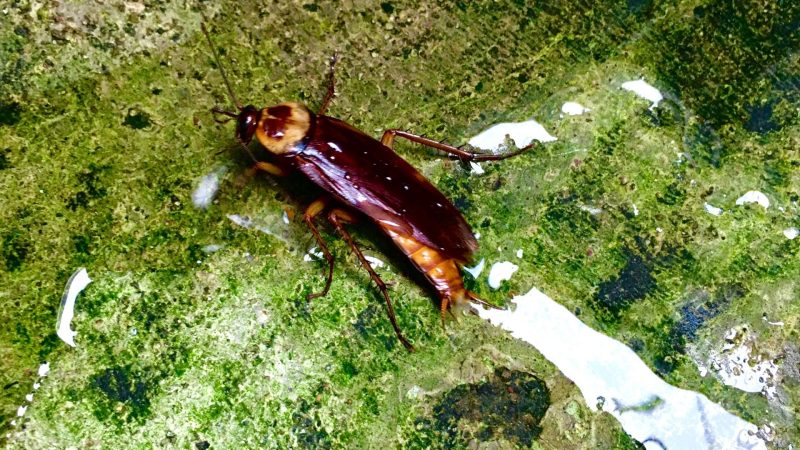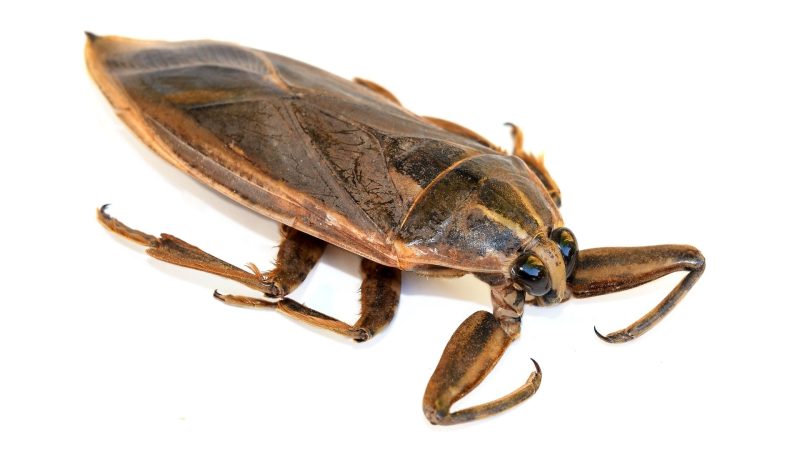Cockroaches are very adaptable creatures and can survive in many circumstances that other insects would not be able to. They are spread and well-known all around the globe. Surviving extreme weather conditions, days without food, finding shelter, and feeding on almost anything, even other cockroaches, makes them one of the most resistant species.
Cockroaches are very dependent on water, and surviving without it is impossible. You will usually find their hiding spot near the water source. Another name for some cockroach species is “water bugs”, as they choose humid areas for shelter, breeding, and living.
Can cockroaches swim? Some species can, but a better word to explain their method is floating. It happens rarely, but they can travel through pipes and drains not by swimming through water but by closing their breathing spiracles, so the water flow carries them without entering their bodies.
Did you know that cockroaches can hold their breath for about 40 minutes before drowning? That’s why flushing the toilet or any attempt to drown them by leaving the tap on for a few minutes is going to fail you.
Cockroaches will simply travel through pipes and drains this way. It is not a method you should use if you are trying to get rid of the cockroach infestation. Reading this article, you will find out more about their behavior around water, so getting a clear image will help you fight the infestation problem.
Related: Do Cockroaches Sleep? | Surprising Facts and Explanations
Cockroach Swimming | Information

Although the way of swimming is not exactly as you may imagine it, cockroaches can survive being in the water for some time. They can use drains to travel from one room to another or even from one apartment to another. That is the reason why cockroach infestation can be extremely hard to defeat in a building or larger facilities.
Can Cockroaches Swim-up Drain?
Cockroaches will crawl up drains, or the water flow will bring them out. As roaches breathe through tiny holes and tubes all over their bodies, they will close them to prevent drowning, and water will simply transfer them from one place to another. As soon as they land on a dry surface, they start crawling again and seeking shelter. Don’t be surprised if you spot a cockroach getting out from your drain! It’s a scary scene indeed, but that is just a sign for you to react, as that usually means the population of cockroaches you are dealing with is pretty big.
Can Cockroaches Swim in Water?
Although real swimming is not an option, they can float and survive being in the water for a long time. Their bodies are light, so floating comes naturally. By closing their respiratory organs when in water, they can easily survive. Even submerged in water, they can stay alive long enough! Water is essential for roaches, and they will always find shelter somewhere near a water source. You will have much more success in eliminating them by removing water and leaving them without it than trying to drown them. When you leave the tap open and force them down the pipes, they will not be underwater for long enough to be drowned.
Can Cockroaches Swim-up Toilets?
They can’t, but it doesn’t mean that you will never see them getting out of the toilet. Drains and toilets are no obstacles for them. They can travel through water, holding their breath for a long duration. Being able to do so can be the reason they suddenly appear in your bathroom. If they end up in your toilet, you’ll be faced with the really surprising scene of a cockroach getting out of your toilet. As awful as it looks, there’s no time for panic. And flushing your toilet is not the solution.
If you want to find a solution, start by checking all the seals around your toilet. Roaches can use the smallest gaps for passage. Fix all the leaks, gaps, and small holes to block all the possible passages. It’s a great start in fighting these pests.
Related: Do Cockroaches Play Dead? | Surprising Facts and Explanations
Which Cockroaches Swim?

Oriental cockroaches are considered to be the species most dependent on water, as they need humid areas for living. That’s why this species is most commonly found in basements. Outside, they usually live under a pile of leaves and areas that provide extra humidity. But other species can survive in water too! None of them can swim.
Can American Cockroaches Swim?
The American cockroach is the largest of all other species. It is, as the name says, the most common house-infesting pest in the USA. Other names for this specific bug are the Bombay Canary and the Palmetto bug. Indoors, American cockroaches are typically found in sewers and drains. It is also the most common cockroach species found in city sewer systems in North America. They choose darker, humid areas for living. Does that mean that American cockroaches swim? It can hardly be called swimming, but they can survive in water. They can travel as the water carries them through pipes and sewer systems.
Can Brown-Banded Cockroach Swim?
Brown-banded cockroaches are called like this due to two light brown bands they have all over their bodies. They are very common and not so easily mistaken with other species, only with German cockroaches, as they have this specific coloring. Like other cockroaches, they don’t need much to survive. Brown-banded cockroaches will choose more dry areas to inhabit, as they don’t need as much moisture to survive. They are usually present in areas with warmer climates. Water is essential for their survival, naturally. If they end up in the water, they will close their breathing structures and prevent suffocation. As they have light bodies, floating will keep them from going underwater and drowning. Like other species, they are not able to swim.
Can German Cockroaches Swim?
German cockroaches are the most common species of all, found worldwide. Their infestation is mostly connected to human-occupied areas, so they are pretty common visitors of restaurants, hotels, buildings, food processing facilities. German cockroaches live in warm and humid places near food and moisture sources. These pests are common inside a home, and many people make mistakes when they spot them in the sink or bathroom – they turn the tap on and wait for the cockroach to go down the drains. This will not kill a German cockroach! Although they don’t swim, German cockroaches will survive under cold, tap water for 15 minutes! This is crucial to know if you are dealing with an infestation in your bathroom or kitchen. Getting rid of them this way won’t help you solve the problem or even harm the cockroach. You are just pushing it to another room or apartment in your building when you let it down the pipes.
Can Hissing Cockroaches Swim?
Madagascar hissing cockroaches are not pests, so they are species only found in nature. These insects live in forests, hiding under leaves or other detritus. Like other cockroaches, they are nocturnal, and they start hunting during the night. The specific thing about this species is that males have large horns, which makes them look specific and unusual. These insects cannot swim, but like other cockroaches, they won’t die immediately if they are in the water. They can just close their breathing holes and stay for some time in the water, floating.
Can Oriental Cockroaches Swim?
The Oriental cockroach is sometimes called a water bug, as this species lives around water sources and searches for moisture, but it can’t swim like other cockroaches. Usually, they choose areas like sewers, damp and dark areas, pipes, and drains for shelter, which makes them species that carry around the most harmful germs and bacteria. If you spot one of them coming out of your sink, taps, or drains, that is a serious sign for you to react! Not only to avoid being faced with an awful scene like cockroach getting out of your sink or drains but this species is considered the dirtiest one. Found mostly in sewers, they collect seriously harmful bacteria and viruses on their bodies. Being in your home means that your environment is not safe anymore, and you should start searching for a way to eliminate them.
Can Baby Cockroaches Swim?
The life of a cockroach is comprised of three stages – stage of egg, nymph, and adult phases. Once the eggs start to hatch, young, immature cockroaches begin to develop. In this stage, they are very fragile. They cannot survive long without food. Also, their ability to survive in water is lower than the ability of an adult. Baby cockroaches cannot swim, but floating is an option for some time if they end up in the water.
Cockroaches in Swimming Pools

What is a water bug, and what is a cockroach? They are often mistaken for one another. Some species of these insects look similar, but they are different. Water bugs prefer to live in waters, and roaches prefer homes. Control methods for these insects are different, so it’s really important to learn how to see the difference.
Cockroaches are a large population of insects, numbering more than 4,000 different species. Water bug is also another name for one species of cockroach, called the Oriental cockroach or black beetle bug.
But the other water bugs are something else. These water bugs have two classifications, semiaquatic bugs that live on the water surface and true water bugs which live beneath the water surface. They have antennae and six legs and sometimes can be mistaken for cockroaches. These water bugs are more solitary insects, while other roaches always surround cockroaches.
If you are dealing with insects in your swimming pool, those are water bugs.
How to Get Rid of Cockroaches in Swimming Pools?

You have learned that those insects in your pool are not cockroaches; instead, they are water bugs. Having water bugs in your pool is a serious problem in no time, as they breed pretty quickly, making your pool unusable. Some of them can even bite! This scenario is not something you’d like to experience, so here are some steps to follow to get rid of them:
Check Your Chlorine Levels Daily
The best remedy is to keep your pool’s hygiene at the highest level. Chlorine is a chemical substance that helps you a lot, keeping sanitary conditions in your pool. Make sure to check chlorine levels before going to bed, and if needed, add some to your pool. Never add chlorine during the daytime, as it can quickly disappear under the sun. Chlorine kills all the algae in the pool, so water bugs are left without food.
Brush and Vacuum the Pool
After you put chlorine in your pool, vacuum and remove any algae residue. Without food, water bugs will simply die. Also, they won’t lay any eggs if there are no algae.
Stay Consistent
Add extra chlorine and clean daily up to four weeks, as that is the time water bugs can survive without food. If this method doesn’t solve your problem, you will have to seek a stronger solution. Using detergents and leaving them for a day or two should be enough to solve the problem. During this time, you should not use the pool. Cleaning filters is also necessary during this process. After you finish, eliminate the old water and put a fresh one. This is a slow and expensive process, but worth it. You will get rid of annoying and persistent water bugs and enjoy your time in the pool.
Prevent Them From Ever Coming Back
After you start using the pool again, set a regular cleaning regime. This is important for your general health, not only to keep the bugs away. To do this, skim the pool every day after usage to clear the algae and debris. After cleaning, brush and vacuum the sides of your pool. Swimming pool covers that you can use during the night are also a great option.
Here is a video on how to get rid of water bugs in your pool:
Summary
Cockroaches are the most common pests inside a household, and sometimes getting rid of the infestation can be extremely hard. Although cockroaches are not such great swimmers, it doesn’t mean that water will easily kill them. The ability to close breathing holes in their bodies makes cockroaches resistant to drowning for quite some time. Underwater cockroaches can stay alive for up to 40 minutes, holding their breath! This explains why any attempt of flushing them down the toilet or drain fails to solve the problem.
Related: 8 Proven Home Remedies for Cockroaches | Effective and Natural Solutions
List of Sources
Cockroaches. University of Minnesota.
Potter, M. (2018). Cockroach Elimination in Homes and Apartments. University of Kentucky.
Jacobs, S. (2017). Oriental Cockroaches. The Pennsylvania State University.
Ebong, S., et al. (2012). Survey of Water Bugs in Bankim, a New Buruli Ulcer Endemic Area in Cameroon. U.S. National Library of Medicine.
- Bed Bug Surge 2025: How to Detect, Prevent, and Safely Eliminate Infestations in Top U.S. Cities - June 18, 2025
- Asian Needle Ants Invade US Homes: 2025 Guide to Identification, Risks, and Effective Control - June 11, 2025
- New World Screwworm Alert: How US Livestock Owners Can Prevent Outbreaks and Protect Herds [Summer 2025 Update] - June 8, 2025
